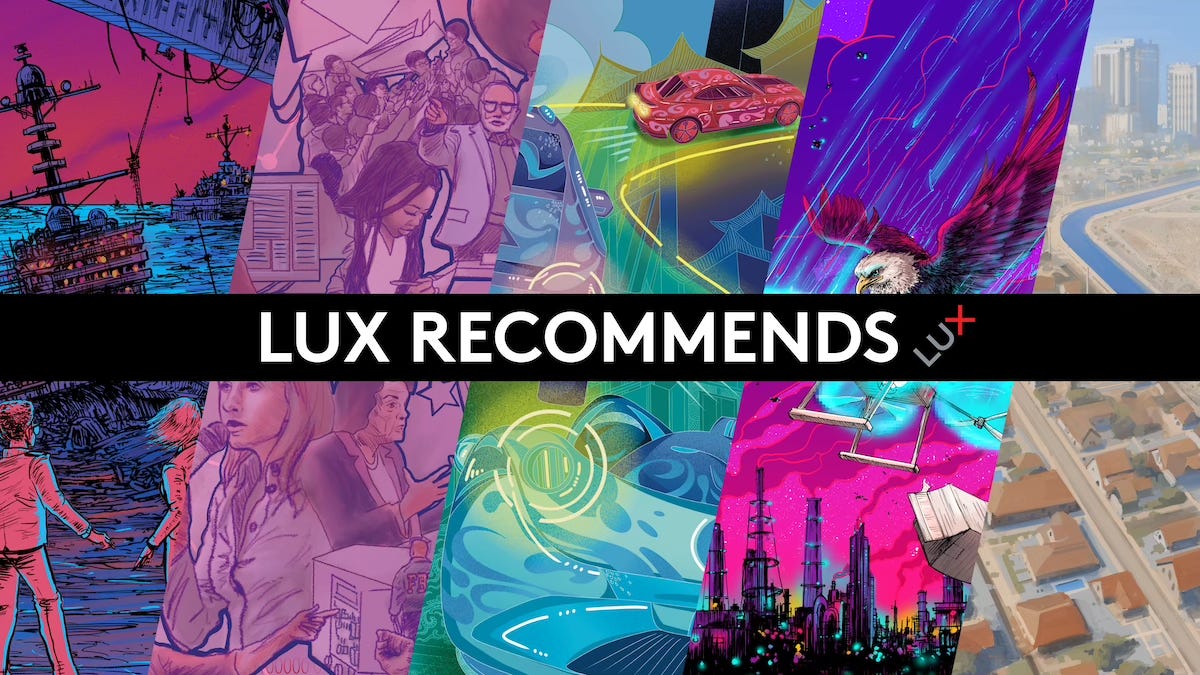Taking China’s perspective on Taiwan, the failure of climate modeling, and notes from the frontiers of tech joblessness. Plus Kirby Ferguson and Ale Matamala Ortiz talk about “collaborating with the entire history of human expression.”
Shameless Self-Promotion
The Special Competitive Studies Project has a nice writeup on the recent collaboration with us on a run-through of Southwest Silicon. Among other takeaways, SCSP noted in their newsletter that:
Tradeoffs aren’t failures, but the price of progress. Every major technology investment comes with competing demands for scarce resources, like water, energy, land, and even capital. The game underscored not just that tradeoffs exist, but how quickly and fairly we can negotiate them. As America sets its sights on an era of reindustrialization, these state and local-level negotiations will be the true front lines of building the next-generation of technology infrastructure – from fabs to data centers to fusion machines and beyond.
From Lux Capital
Majestic Labs, a Lux portfolio startup reimagining AI infrastructure to reduce cloud companies’ spend on data centers, announced this week that it has raised $100 million. Meanwhile, Israel-based cybersecurity company Tenzai came out of stealth. The company is aiming to use AI to help customers find vulnerabilities in their critical systems.
Bilal Abu-Ghazaleh, formerly of Scale AI, has raised $9 million in seed capital, including from Lux, for his new firm, 1001 AI, which seeks to build AI-native operating systems for critical industries. And the New York Times published a major report on successes in the field of xenotransplantation, including those led by Lux’s eGenesis, which next year will begin a “trial of kidneys transplanted from pigs that have undergone 69 gene edits.”
Finally, if you missed the Lux AI Summit, check out the videos from the event on Lux’s YouTube channel, including this session with Scott Wu of Cognition. Scott discusses the future of software engineering, predicting major advancements in autonomous AI agents over the next 12 months.
From around the web
1. Red teaming
I’m starting off this week with a look at a new (non-Riskgaming) war game: Syracuse University recently had experts role-play as Chinese military planners considering Taiwan invasion scenarios. By forcing players to take on the Chinese perspective rather than the American one, the exercise exposed a blind spot in U.S. military planning — we neglect China’s incentive to pursue coercive strategies that exploit American political hesitancy to enter a war where U.S. forces weren’t attacked first. This is exactly what wargaming is designed to do!
The exercise forced participants to confront an uncomfortable truth about China’s military capabilities. Despite decades of modernization, the People’s Liberation Army has not fought a major conflict since 1979. It has never conducted an amphibious assault on a major scale. Its logistics remain untested. Its command structure is riddled with political interference. In contrast to most wargames that portray the Chinese military as a competent machine operating at maximum efficiency, the perspective from Beijing is likely more sobering.
These limitations don’t make China weak — they make it cautious. Why attempt a Normandy-style invasion when missile strikes and economic strangulation might achieve the same goal? Why risk military humiliation when political victory remains possible? Participants found themselves naturally gravitating toward strategies that minimized operational complexity and maximized the potential to de-escalate if things went badly wrong and then re-escalate later at a more favorable time.
2. Tao of tech
In other “what’s China thinking?” news, a new piece by Afra Wang in Asterisk Magazine explores the intellectual influences shaping China’s tech elite. Apparently, it’s a bold mix of Silicon Valley’s startup canon (Jobs, Thiel, Wired’s Kevin Kelly) with Maoist tactical texts, classical Chinese philosophy, and literary works. We avoid learning more about the deeper foundations of the Chinese tech sector at our peril.
The red canon and Silicon Valley canon never contradict — they coexist seamlessly within the same enterprise. Huawei, as one of the world’s most successfully globalized companies, appears intensely patriotic precisely because of this effortless code-switching between intellectual frameworks. Internally, Huawei has nearly replicated IBM’s Integrated Product Development process wholesale, adopting thoroughly Western management practices. Yet from the outside, you would never detect the company’s profound absorption of Silicon Valley orthodoxy. This dual fluency — speaking the language of revolutionary struggle for internal mobilization while implementing McKinsey-grade operational excellence — represents a uniquely Chinese form of corporate bilingualism. The company’s public patriotism masks its private cosmopolitanism.
3. Rebooting Damascus
Over in Rest of World, Emily Wither has a fascinating interview with Syria’s new communications minister, Abdulsalam Haykal, who faces the daunting task of rebuilding the country’s devastated tech infrastructure after 14 years of civil war. Haykal’s “digital Silk Road” plan aims to transform Syria into a data corridor through private sector investment.
Submarine cables carry traffic through the Red Sea to Asia, and this route carries 17% of global internet traffic, and 90% of the Europe-Asia traffic. This is a choke point for the world. Syria, through our Mediterranean coastline, can provide another route.
So if you build cable landing stations on the Syrian coast, and then you build terrestrial routes through Jordan, Saudi Arabia, out to the international cable systems in the Arab Gulf, and then the Indian Ocean, this first provides route diversity. So from a geopolitical point of view, this is something that countries are seeking, hyperscalers [companies that operate large cloud and data centers] need, and so on. But also, the Syrian route would be shorter by around 6,000 kilometers (3,700 miles) for a round trip.
4. Model uncertainty
You should also check out David Stainforth’s latest in Aeon. David writes that the earth system models we use to predict our climate future are too flawed to make reliable forecasts. The climate science community continues to rely on them, though, investing billions in making them higher-resolution rather than addressing their fundamental limitations, which we may never overcome.
If we understand the uncertainties well, we can bring our values to bear on the risks we are willing to take. Uncertainty therefore needs to be at the core of adaptation planning while also being the lens through which we judge the value of climate policy and the energy transition. In my view, climate researchers and modellers wanting to support society should focus on understanding, characterising and quantifying uncertainty, and avoid the trap of seeking climate models that make reliable predictions. They may well never exist.
5. Hire wire
Finally, as we think about the future of AI and jobs, it is worth taking a moment to step back and consider the stories of some individuals who are already feeling displaced. “Notes From an Unemployed New Grad Watching the Job Market Break” chronicles a computer science graduate’s struggle to find work in a “broken” job market, where entry-level positions are disappearing as companies increasingly replace junior workers with AI tools, offshore teleoperation, and automation. Despite low official unemployment, the writer posits, an entire generation faces a reality where doing everything right no longer guarantees a foothold in the economy.
I do not know how many jobs will exist in twenty years, or whether my own work will sit far enough into the tail of the distribution to matter. I will certainly try to become an out of distribution human by doing a lot of different things, and by refusing to live entirely in the centre of the curve but if your entire life plan rests on being a respectable, central case worker, doing a standard job in a standard company, I think you should at least stare straight at how much effort is going into eroding that category. If your politics rest on the idea that everyone will work full time and find dignity there, you should stare at it too. The twentieth century spent a lot of intellectual and moral effort glorifying labour because economies needed people to show up every day. The twenty-first century is starting to build machines and systems that do not need quite as many of us.
Editor’s note: After the publication of our newsletter, this recommended post was taken down.





